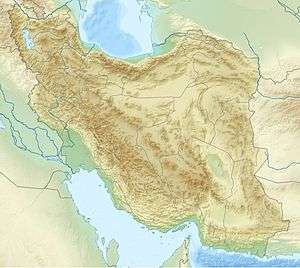Do-Ashkaft Cave
 location in Iran | |
| Location | north of Kermanshah, western Iran |
|---|---|
| Region | Kermanshah Province, Iranian Kurdistan |
| Coordinates | 34°24′3.4″N 47°7′50″E / 34.400944°N 47.13056°ECoordinates: 34°24′3.4″N 47°7′50″E / 34.400944°N 47.13056°E |
| Type | Cave |
| Part of | Kermanshah Plain |
| History | |
| Material | limestone |
| Periods | Middle Paleolithic |
| Associated with | Neanderthals |
| Site notes | |
| Excavation dates | 1996 |
| Archaeologists | F. Biglari, S. Heydari |

The Do-Ashkaft Cave, being a Middle Paleolithic cave site, is located north of Kermanshah, near Taq-e Bostan, Iran about 1,600 m (5,200 ft) above sea level. Its entrance faces south of Meywala Mount, overlooking the national park of Kuhestan. The site was first visited in 1996 by Iranian researchers F. Biglari and S. Heydari-Guran[1] and during the following four years a series of surface surveys were made at one-month intervals, which resulted in a rich collection of Middle Paleolithic lithic artifacts.[2]
The main chamber of the cave is 23 m (75 ft) deep and 15 m (49 ft) wide. Large areas of Breccia sediments indicate lateral percolation of water into the cave sediments as a substantial amount of the cave sediments may have been washed away. The sediments at the entrance yielded numerous animal bones, charcoal and flint tools, Middle Paleolithic artifacts, such as side-scrapers and a Mousterian point. Animal bones show signs of human involvement in their accumulation during the Mousterian occupation. They include a fragment of a right mandible of an adult specimen and an upper third right molar of a sub-adult ruminant, both allocated to wild Caprinae.
In 1999 an area of about 7 km2 (2.7 sq mi) including 14 caves and rock-shelters was surveyed, where Upper Palaeolithic and later lithic assemblages came to light. Records and samples made by S. Heydari provide a paleo-environmental sequence for the region from the late Middle Pleistocene to the Holocene. The Neanderthal occupants of the cave made tools from local raw material outcrops around the cave, which classify as to be Mousterian.[3]
References
- ↑ "Dr. Saman Heydari-Guran". Uni Tuebingen. Retrieved August 22, 2016.
- ↑ "Do-Ashkaft: a recently discovered Mousterian cave site in the Kermanshah Plain, Iran.". the free library. Retrieved August 22, 2016.
- ↑ "The Preliminary Observations on Middle Palaeolithic Raw Material Procurement and Usage in the Kermanshah Plain, the Case of Do-Ashkaft Cave". Fereidoun Biglari. Retrieved August 22, 2016.

Bibliography
- Fereidoun Biglari and Saman Heydari (2001) Do-Ashkaft: a recently discovered Mousterian cave site in the Kermanshah Plain, Iran, Antiquity, Vol 75, No: 289, Page: 487–488
- Biglari, F.(2007) Approvisionnement et utilisation des matières premières au Paléolithique moyen dans la plaine de Kermanshah Iran) : le cas de la Grotte Do-Ashkaft, M. H. Moncel, A. Moigne, M. Arzarello, C. Peretto (eds), Aires 'approvisionnement en matières premières et aires d'approvisionnement en resources alimentaires Approche intégrée des comportements, Workshop 23, XV Congrès UISPP, Lisbonne, Vol. 5, BAR International Series 172
External Links
- Kermanshah Cultural Heritage Organization web site
- Do-Ashkaft Cave
- Lithic raw material use in Do-Ashkaft
Gallery
 big cave
big cave on top of small cave
on top of small cave small Cave floor due to rain water from roof to cool wrought
small Cave floor due to rain water from roof to cool wrought inside the cave. in the end of the cave we can see tunnel
inside the cave. in the end of the cave we can see tunnel inside big cave; in front of cave is Park of Kuhestan (mountain's park)
inside big cave; in front of cave is Park of Kuhestan (mountain's park) outside small cave
outside small cave inside small cave; in front of cave is kermanshah city
inside small cave; in front of cave is kermanshah city inside small cave
inside small cave inside big cave, view of hole one wall
inside big cave, view of hole one wall
